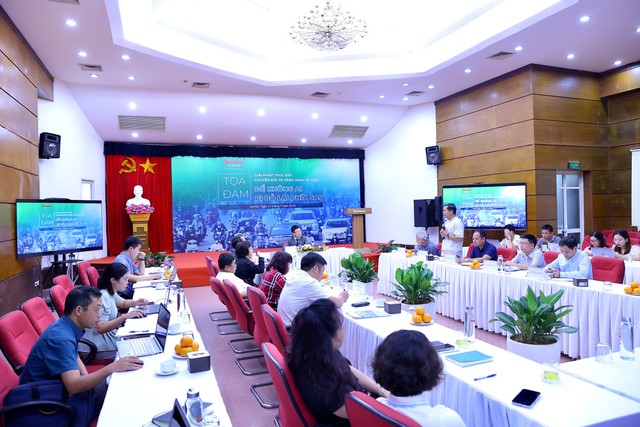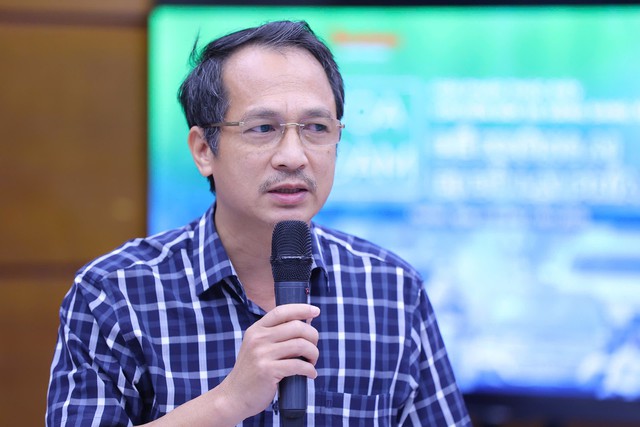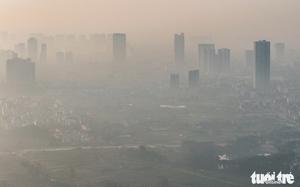
Officials attend a roundtable on traffic emissions hosted by Tien Phong (Vanguard) newspaper in Hanoi, July 21, 2025. Photo: Trong Tai
At a roundtable hosted by Tien Phong (Vanguard) newspaper in Hanoi, representatives from the Ministry of Agriculture and Environment and city-level authorities discussed strategies for reducing emissions and improving air quality in the capital.
Nguyen Hoang Anh, acting head of the environmental quality management division under the Ministry of Agriculture and Environment, said the issue of air pollution in Hanoi had been raised at the highest political levels and cited data showing a significant deterioration in air quality since the COVID-19 pandemic.
“During the COVID-19 lockdowns, air quality in Hanoi and Ho Chi Minh City improved significantly,” Anh said.
“But since economic activities resumed, we have seen a return to frequent pollution, with 47 severely polluted days in the last quarter alone.”
At 7:00 am on Saturday, three air quality monitoring stations recorded hazardous levels just before a thunderstorm, she added.

Nguyen Hoang Anh, acting head of the environmental quality management division under the Ministry of Agriculture and Environment, speaks at a roundtable on traffic emissions hosted by Tien Phong (Vanguard) newspaper in Hanoi, July 21, 2025. Photo: Trong Tai
Anh noted that while a recent report by Hanoi authorities attributed more than 60 percent of local air pollution to traffic, the ministry’s estimate was lower.
According to ministry data, emissions from vehicles contribute around 12 percent, with road dust at 23 percent, construction activity at 17–18 percent, and open burning—including crop residue and waste tyres—at 15–16 percent.
“These figures were compiled from multiple sources and presented in the ministry’s report to the prime minister," Anh said, adding that emissions inventories remain limited due to a lack of standardized methodology and funding.
Nguyen Dong Phong, head of the Motor Vehicle Emissions Testing Center under Vietnam Register, said Prime Ministerial Directive No. 20 outlines steps to curb emissions from transport, especially from the country’s nearly 70 million motorbikes, which are concentrated in urban areas.

Nguyen Dong Phong, head of the Motor Vehicle Emissions Testing Center under Vietnam Register, speaks at a roundtable on traffic emissions hosted by Tien Phong (Vanguard) newspaper in Hanoi, July 21, 2025. Photo: Trong Tai
While Vietnam has regulated emissions from cars since 2006, most motorbikes on the road today are not subject to emissions checks, Phong said.
He advocated for a gradual transition from petrol-powered motorbikes to electric two-wheelers, which he said could significantly reduce emissions.
However, he noted that such a shift would require state support and infrastructure investment, particularly in charging networks.
“It will impact vulnerable groups the most, so any policy must ensure support mechanisms are in place,” he said.
Phong also highlighted the need to manage battery waste and invest in recycling and repurposing systems to address the environmental risks associated with electric vehicles.

Hoang Anh Le, associate professor at Vietnam National University in Hanoi, speaks at a roundtable on traffic emissions hosted by Tien Phong (Vanguard) newspaper in Hanoi, July 21, 2025. Photo: Trong Tai
Hoang Anh Le, associate professor at the Vietnam National University-Hanoi, cited joint research with UK scientists that found traffic-related pollution in Hanoi varies by time and vehicle type.
Motorbikes are the main emitters during the day, while heavy trucks dominate emissions at night, he said.
“Motorbikes are the most widespread vehicles, often lacking emission treatment systems, and they contribute directly to urban pollution,” Le said.
In contrast, most cars are equipped with exhaust treatment systems, reducing their impact on air quality.
Low traffic speeds also worsen emissions.
The average vehicle speed in Hanoi is around 35 km/h, which increases fuel consumption and pollutant output, Le added.



Max: 1500 characters
There are no comments yet. Be the first to comment.